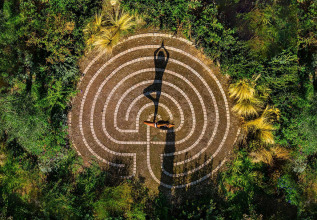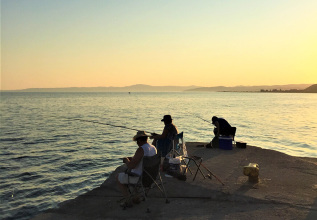5 MIN
TRAVEL TIPS
Paradise lost?

It is also the seat of my family home since 1940 when we were displaced from Piraeus by errant bombs. It was then a 20 hectare wild garden in an area aptly called Paradisos, in which a modest neoclassical villa stood replete with stables, a vineyard, olive trees, a well and walkways. Located halfway between Maroussi and Halandri, it stood ‘alone and palely loitering’.
Travelling from the house to Maroussi in the 1950s one passed numerous pottery workshops (the ground was clay-based), the IVI soft drink factory and the Berkshire Stocking Company, owned by the Moraitis family (founders of the school of that name in Psychico). Maroussi’s ancient name was Athmonon, and it represented one of the ten Athenian sub-cities. The area held a main temple, where Amarysia Artemis (Diana), the goddess of hunting, was adored, and the city’s modern name - Amaroussion - derives from that of the goddess. Water, clay, and Katsimbalis, the Colossus of Maroussi in Henry Miller’s book, shaped the reality and ideology of this Attica village that supplied water to Athens, ceramic pots to visitors from afar and a mental image of Greece that predated Zorba in the cultural awareness among the English-reading world.
In 1896 Spyros Louis, a water-carrier from Maroussi who trekked to Athens daily with his precious cargo, became immortalized by winning the first Olympic Marathon race. Reportedly, the King offered Louis any gift he would care to ask of him, and all Louis could think of was a donkey-drawn carriage to help him in his water-carrying business. In his book Spirit of Place, Lawrence Durrell describes Katsimbalis’ residence in Maroussi as a house out of Wuthering Heights, where in the 1930s George Seferis, Miller, Ghikas the painter and Constantine Tsatsos would meet on Sundays to talk about Greece, poetry and people.
Aliki Vouyouklaki, the celebrated Greek film actress, was born and brought up in Maroussi.
Less well-known is Manos Danos, the finest ceramicist in Maroussi between 1950 and 1960.
The new Maroussi is epitomized by The Mall, an immense shopping and entertainment emporium, with underground parking for 2,500 cars, which has a host of restaurants for every taste.
My favourite is Small Italy, located above the main restaurant floor, with an affordable menu of pizza and pasta.
The Mall overlooks the Olympic Stadium, an impressive complex of architectural unity now used for major concerts and football games.
In front of the stadium, Maroussi’s second shopping behemoth, the high-end Golden Hall, opened in a building that used to house the Olympic press centre.
The Riding Club in Paradisos was built in the early 1950s on a piece of land from our garden.
I used to ride there and once received a bronze medal for jumping. Unfortunately I was disgraced and banned from the club because I forgot to remove my riding hat during the award presentation by Queen Frederica. In those days we were able to hack out from the club into the woods and fields of Maroussi, home to small farms, herds of goats and sheep, and foxes. Many of the club members were with the mounted police or army units. There were also scions of famous families like the Baltazis and Razelos. The club is still operation today under the presidency of Lena Levidou, but no rider would dare leave the premises in the current cacophony of traffic and confusion.
Of special interest in Maroussi is the Spatharis Museum of Shadow Theatre, dedicated to Karagiozis, a shadow figure that lampooned the Greek state and politics in general and was ubiquitous in Greece for the last 150 years.
Meanwhile, on Ploutarch Street near the railway station is a house where the Greek painter Yannis Tsarouchis lived and worked, which is worth visiting to see his works.
Our family home remains, a small haven of greenery amid the high-rises and shopping centres, enjoyed by tortoises, hedgehogs and hundreds of birds.
The stables became a makeshift soap factory during and after the war, but in 1980 I restored the buildings (dating from the Turkish period) and turned the factory into an industrial museum and exhibition hall.
In the late 1970s we built a tennis club on the grounds with six courts and a pool, which was eventually sold to a Japanese concern who built a cement office block in its stead.
The soap factory was expropriated by the Greek state in 1999. They abandoned the protected buildings and built a public school, destroying over 500 trees in the process.
Today the house and gardens, all restored, provide olive oil and pistachios. We have over different 300 trees and bushes, mostly Leylands, Goldcrests, Rosemary bushes and pine trees, as well as extensive lawns and a stone pergola where musical events are held during the summer months.
There is little to recommend Maroussi to a visitor today, baring the Olympic stadium. It is an example of city sprawl and eco-cide that characterizes most of Attica. Nevertheless, I love living here, enjoying the oasis of my garden, the Greek wine at nearby tavernas and the occasional pasta at The Mall.
Article by Insider



